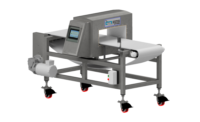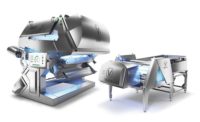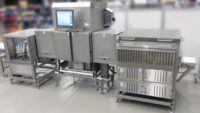As bakers and snack manufacturers continue to produce a greater variety of goods on their production lines, flexible metal detectors that can reliably handle many types of products are growing essential to operations.
“Metal detectors are being put in positions that require them to scan a variety of products, yet remain very accurate for every product,” says Robert P. Slauson, sales engineer, Advanced Detection Systems, Milwaukee. “Thus, it is important that bakers and snack food producers work with suppliers who will address specific applications and custom-build systems to meet those specifications.”
These equipment suppliers will also be able to offer bakers and snack producers metal detection systems with numerous other attributes, including easy use and setup, improved rejection and data capture, and food-safety features.
Easy use is more important than it was five years ago, according to Bob Ries, lead product manager, metal detection and X-ray inspection, Thermo Fisher Scientific Inc., Minneapolis. “Metal detectors are complex instruments designed to react to small signals in difficult environments,” he explains. “For this reason, they can be difficult to understand and use. Food processors are demanding easy-to-use interfaces with more automatic setup and diagnosis, and plain language menus that include step-by-step wizards. Remote access also is a frequent request.”
Easy operation and setup is critical to efficient metal detection, agrees Tom Tonra, director of marketing, communications and product management, Anritsu Industrial Solutions USA, Elk Grove Village, IL. “More and more, food processors are faced with the challenge of keeping their employees properly trained,” he says. “Anritsu has simplified the setup and operations process to ensure consistent metal detection. Supplying equipment with operational touchscreens in multiple languages is one of the ways we are doing this.”
Bakers and snack producers are also increasingly concerned with capturing data from their metal detection systems and thus requesting features such as a USB port, Ethernet connectivity capability and data-management software, says Geri Foley, metal detection sales manager, Mettler Toledo Product Inspection, Tampa, FL. “ProdX, a Mettler Toledo data collection and storage system, allows facilities to collect and store production data that can be used to improve efficiency,” she says. “Also, the data can easily be retrieved in the event of an FDA inspection.”
More products, fewer rejections
Metal detection equipment that can efficiently and cost-effectively handle many different types of products with no or minimal false rejections are in demand, too. New high- and multifrequency systems are the solution for many bakers and snack producers.
“For neutral products, such as potato chips, systems using a single high frequency provide superior, cost-effective metal detection,” says Todd Grube, product manager, inspection systems, Heat and Control Inc., Hayward, CA. “In the past, food processors found that higher-frequency detectors were more susceptible to errors caused by environmental interference, or noise produced by electric motors and short-range radios commonly used in many plants. CEIA’s THS/G21 metal detectors negate this type of interference to reduce false rejects, while offering high sensitivity to metal contaminants.”
Mettler Toledo’s Profile Advantage metal detector features multi-simultaneous frequency technology that ensures that the highest levels of detection sensitivities are achieved by analyzing product signal data captured across a wide spectrum of frequencies. In addition, product signal suppression virtually eliminates false triggering by suppressing unwanted product signals.
“This new technology makes the Profile Advantage a valuable inspection tool for bakery and snack food products that include a high degree of moisture, a condition that triggers many false rejects in metal detectors,” says Foley. “The traditional solution has been to reduce the sensitivity of the metal detector to eliminate false rejects, thereby limiting its ability to detect all contaminants. By suppressing those false signals, the Profile Advantage can inspect products at full sensitivity, ensuring more-effective inspection and maximizing product safety.”
Advanced Detection Systems’ ProScan Max-II metal detector features enhanced performance validation and IP69K wash-down credentials, according to Slauson. Performance validation allows food processors to set a schedule for confirming metal detector performance. An alarm is activated when the test is scheduled and remains on until the test has been performed. These events are logged and available for review by production supervisors and outside auditors.
The CEIA MS 21, available from Heat and Control, simultaneously uses a spectrum of multiple frequencies to identify and mask product effect, while maintaining sensitivity to all metals, including 316 stainless steel. The company offers a variety of models for different applications and budgets. The economical THS/21e metal detector is available in single- and three-frequency models. In addition, CEIA’s Auto-Learn system scans products in one pass to reduce setup time and inspection errors.
Anritsu offers different model sizes to meet the various metal detection needs of bakers and snack producers. Its duw-h series includes models that can handle pass widths of 210, 300 and 450 mm and heights from 45 to 180 mm. The high-sensitivity head and new algorithms provide a high level of sensitivity, says Tonra.
Thermo Fisher recently introduced the Quickfit metal detector conveyor. Compatible with all of the company’s APEX metal detectors, the modular, high-function conveyor is designed for quick manufacture and delivery.
Key Technology Inc., Walla Walla, WA, manufactures a variety of vibratory conveyors and sorters that augment the metal detection process. The company’s newest inspection system for bakers and snack food plants is the Taurys chute-fed sorter, which is suitable for processing nuts, dried fruits, sunflower seeds and trail mix. Compared to previous chute-fed sorters, Taurys improves the accuracy of foreign-material and defect removal, while reducing false rejects to improve product quality and maximize yield, according to John Kadinger, marketing manager for the company.
Food safety goes high-tech
Increased government emphasis on food safety has bakers and snack manufacturers seeking equipment to help them meet more stringent food-safety regulations.
All of Advanced Detection Systems’ ProScan Max II metal detectors meet IP69K wash-down standards. They can be subjected to high-pressure and high-temperature water during the many cleaning cycles prevalent in manufacturing facilities.
Key Technology added several sanitary features to its vibratory conveyors and shakers. It replaced the industry-standard 2B mill finish in product contact zones with a rotary polish, which provides a smoother stainless steel surface that facilitates cleaning and resists bacteria.
CEIA 21-Series metal detectors, available from Heat and Control, meet FDA Title 21 pharmaceutical standards for inspection data security, integrity and traceability. “While not yet required in the food industry, this standard raises food-safety programs to a higher level,” says Grube.
CEIA also offers THS Production Plus software, which provides statistical data and report generation, all compliant with FDA food-safety standards. The software acquires data from multiple metal detectors via an Ethernet LAN. It provides connection to an external database for each metal detector event, which facilitates database management, operator auditing and backup of detection events.
X-ray vs. metal
Foil tray, metalized film packaging and other factors, meanwhile, are prompting some bakers and snack producers to migrate away from metal detection to X-ray inspection. “X-ray technology continues to come down in price and improve from a reliability standpoint, which removes previous barriers to adoption,” says Ries. “X-ray has the benefit of finding metallic and nonmetallic foreign objects, thus improving food safety. It also allows food processors to use vision software for product inspection to verify overall quality.”
The latest development in X-ray inspection from Heat and Control is Ishida’s IX-G2 dual-energy X-ray system. “The system employs dual-energy sensors for highly sensitive detection of low-density and thin foreign objects,” explains Grube. “By comparing images from two energy levels, the IX-G2 analyses the absorption of X-rays to detect foreign objects by density and type of material.”
Tonra also says more food processors are looking at X-ray technology to improve food safety on their lines. He cites several reasons for the increase, such as elimination of stone pieces in harvested products; elimination of fine, small wire pieces from the sifting process in bakeries; and the increased use of foil or film packaging for products that do not easily pass through metal detection units.
“Metal detectors still have a valuable place in the industry,” notes Tonra, “but the use of X-ray systems is growing rapidly.”









